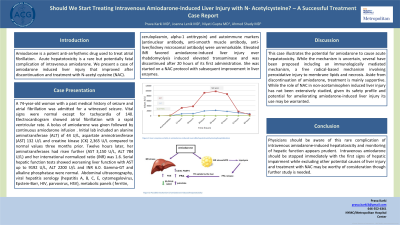Tuesday Poster Session
Category: Liver
P3910 - Should We Start Treating Intravenous Amiodarone-Induced Liver Injury with N-Acetylcysteine? A Successful Treatment Case Report
Tuesday, October 24, 2023
10:30 AM - 4:00 PM PT
Location: Exhibit Hall

Has Audio

Prava Karki, MD
Metropolitan Hospital Center
New York, NY
Presenting Author(s)
Prava Karki, MD1, Joanna Lenik, MD2, Niyati Gupta, MD3, Ahmed Shady, MD1
1Metropolitan Hospital Center, New York, NY; 2NYC Health + Hospitals/Metropolitan Hospital, Manhattan, NY; 3NYCHH/Metropolitan Hospital, New York, NY
Introduction: Amiodarone is a potent anti-arrhythmic drug used to treat atrial fibrillation. Acute hepatotoxicity is a rare but potentially fatal complication of intravenous Amiodarone. We present a case of Amiodarone induced liver injury that improved after discontinuation and treatment with N-acetyl cysteine (NAC
Case Description/Methods: A 74-year-old woman with a past medical history of seizure and atrial fibrillation was admitted for a witnessed seizure. Vital signs were normal except for tachycardia of 140. Electrocardiogram showed atrial fibrillation with a rapid ventricular rate. She was treated with a bolus of amiodarone followed by a continuous amiodarone infusion. Initial laboratory data included an alanine aminotransferase (ALT) of 44 U/L, aspartate aminotransferase (AST) 132 U/ L and creatinine kinase (CK) 2,365 U/L compared to normal values three months prior. Twelve hours later, her aminotransferases had risen further (AST 3,150 U/L, ALT 784 U/L) and her international normalized ratio (INR) was 1.6. Serial hepatic function tests showed worsening liver function with AST up to 9192 U/L, ALT 2200 U/L and INR 6.0. Gamma-GT and alkaline phosphatase were normal. Abdominal ultrasonography, viral hepatitis serology (hepatitis A, B, C, E, cytomegalovirus, Epstein-Barr, HIV, parvovirus, HSV), metabolic panels (ferritin, ceruloplasmin, alpha-1 antitrypsin) and autoimmune markers (antinuclear antibody, anti-smooth muscle antibody, anti-liver/kidney microsomal antibody) were unremarkable. Elevated INR favored high suspicion for amiodarone-induced liver injury over rhabdomyolysis induced elevated transaminase and was discontinued after about 20 hours after its first administration and she was started on a NAC protocol with subsequent improvement in her liver enzymes.
Discussion: This case illustrates the potential for amiodarone to cause acute hepatotoxicity. While the mechanism is uncertain, several have been proposed including an immunologically mediated mechanism, a free radical-based mechanism involving peroxidative injury to membrane lipids and necrosis, and a mechanism based on increased expression of the PPAR-α gene secondary to disrupted hepatic lipid mechanism. Aside from discontinuation of amiodarone, treatment is mainly supportive. While the role of NAC in non-acetaminophen induced liver injury has not been extensively studied, given its safety profile and potential for ameliorating amiodarone- induced liver injury its use may be warranted.
Disclosures:
Prava Karki, MD1, Joanna Lenik, MD2, Niyati Gupta, MD3, Ahmed Shady, MD1. P3910 - Should We Start Treating Intravenous Amiodarone-Induced Liver Injury with N-Acetylcysteine? A Successful Treatment Case Report, ACG 2023 Annual Scientific Meeting Abstracts. Vancouver, BC, Canada: American College of Gastroenterology.
1Metropolitan Hospital Center, New York, NY; 2NYC Health + Hospitals/Metropolitan Hospital, Manhattan, NY; 3NYCHH/Metropolitan Hospital, New York, NY
Introduction: Amiodarone is a potent anti-arrhythmic drug used to treat atrial fibrillation. Acute hepatotoxicity is a rare but potentially fatal complication of intravenous Amiodarone. We present a case of Amiodarone induced liver injury that improved after discontinuation and treatment with N-acetyl cysteine (NAC
Case Description/Methods: A 74-year-old woman with a past medical history of seizure and atrial fibrillation was admitted for a witnessed seizure. Vital signs were normal except for tachycardia of 140. Electrocardiogram showed atrial fibrillation with a rapid ventricular rate. She was treated with a bolus of amiodarone followed by a continuous amiodarone infusion. Initial laboratory data included an alanine aminotransferase (ALT) of 44 U/L, aspartate aminotransferase (AST) 132 U/ L and creatinine kinase (CK) 2,365 U/L compared to normal values three months prior. Twelve hours later, her aminotransferases had risen further (AST 3,150 U/L, ALT 784 U/L) and her international normalized ratio (INR) was 1.6. Serial hepatic function tests showed worsening liver function with AST up to 9192 U/L, ALT 2200 U/L and INR 6.0. Gamma-GT and alkaline phosphatase were normal. Abdominal ultrasonography, viral hepatitis serology (hepatitis A, B, C, E, cytomegalovirus, Epstein-Barr, HIV, parvovirus, HSV), metabolic panels (ferritin, ceruloplasmin, alpha-1 antitrypsin) and autoimmune markers (antinuclear antibody, anti-smooth muscle antibody, anti-liver/kidney microsomal antibody) were unremarkable. Elevated INR favored high suspicion for amiodarone-induced liver injury over rhabdomyolysis induced elevated transaminase and was discontinued after about 20 hours after its first administration and she was started on a NAC protocol with subsequent improvement in her liver enzymes.
Discussion: This case illustrates the potential for amiodarone to cause acute hepatotoxicity. While the mechanism is uncertain, several have been proposed including an immunologically mediated mechanism, a free radical-based mechanism involving peroxidative injury to membrane lipids and necrosis, and a mechanism based on increased expression of the PPAR-α gene secondary to disrupted hepatic lipid mechanism. Aside from discontinuation of amiodarone, treatment is mainly supportive. While the role of NAC in non-acetaminophen induced liver injury has not been extensively studied, given its safety profile and potential for ameliorating amiodarone- induced liver injury its use may be warranted.
Disclosures:
Prava Karki indicated no relevant financial relationships.
Joanna Lenik indicated no relevant financial relationships.
Niyati Gupta indicated no relevant financial relationships.
Ahmed Shady indicated no relevant financial relationships.
Prava Karki, MD1, Joanna Lenik, MD2, Niyati Gupta, MD3, Ahmed Shady, MD1. P3910 - Should We Start Treating Intravenous Amiodarone-Induced Liver Injury with N-Acetylcysteine? A Successful Treatment Case Report, ACG 2023 Annual Scientific Meeting Abstracts. Vancouver, BC, Canada: American College of Gastroenterology.
